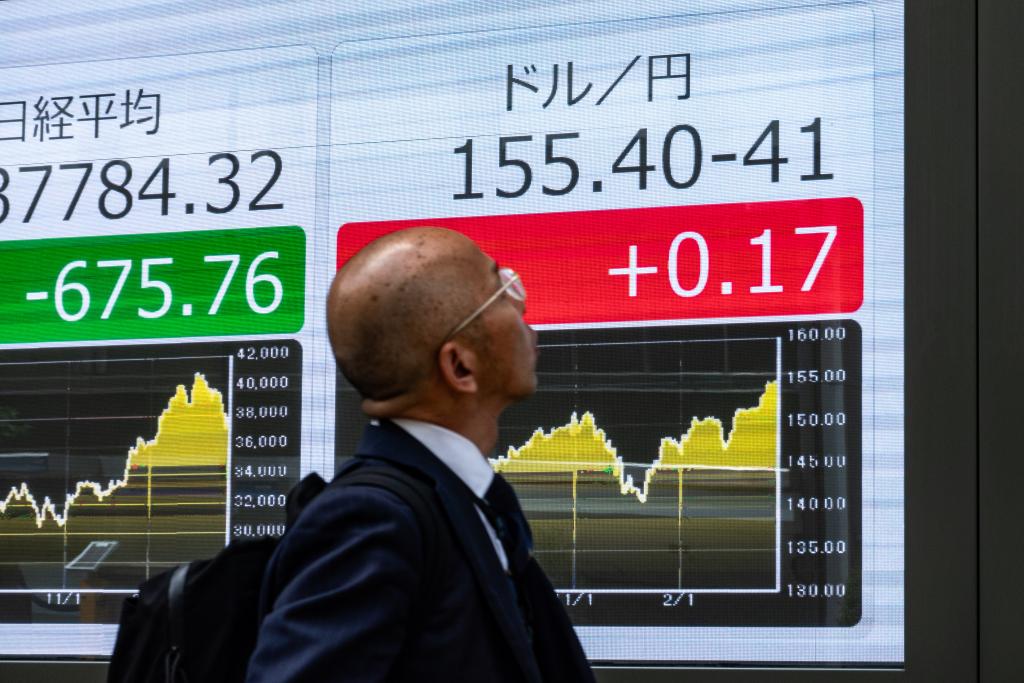In recent times, the exchange rates of multiple currencies such as the Japanese yen, Korean won, Indian rupee, and Indonesian rupiah against the US dollar have dropped significantly, causing market concerns about the stability of capital markets in emerging economies. What are the recent trends of these currencies? What negative impacts have it had on the economies of relevant countries?
Analysts say that the main reason for the significant depreciation of relevant currencies is the so-called "strong US dollar", which means that the Federal Reserve's policy has led to a significant appreciation of the US dollar, causing capital to flow back from emerging markets and exacerbating the risks faced by emerging economies and the world economy.
On April 25th, pedestrians walked past an electronic screen in Tokyo, Japan that displayed real-time exchange rates. Photo by Xinhua News Agency reporter Zhang Xiaoyu
Multinational currencies are plagued by troubles
The Bank of Japan decided on the 26th to maintain its current monetary policy unchanged and did not implement quantitative tightening as expected by the outside world. After the news was released, the Japanese yen, which had been continuously declining, plummeted again. The Japanese yen in the Tokyo foreign exchange market fell below 158 yen to the US dollar, once again breaking the lowest level since May 1990.
"The trend is shocking!" Akira Ohmori, Chief Japanese Strategist at Mizuho Securities, said in a media interview, indicating that the Japanese government will intervene in the market at any time. However, the analyst said, "Now it's up to the US dollar. With the US dollar so strong, (Japan) intervention will not be effective."
Just a few days ago, people were still worried about whether the yen would fall below the "dangerous level" of 155 yen to 1 dollar. On the 23rd, Japanese Finance Minister Toshiichi Suzuki stated, "We will not rule out any options to deal with excessive volatility properly." It has been proven that the government's statement has not improved market sentiment.
The Japanese yen is not the only currency that has been troubled recently. At the end of last year, the exchange rate of the Korean won to the US dollar was less than 1300 Korean won to the US dollar, and it has now dropped to nearly 1380 Korean won to the US dollar. On April 16th, we briefly missed the 1400 won mark during trading. The previously held US, Japanese, and South Korean finance ministers meeting stated that the three countries "recognize Japan and South Korea's serious concerns about the recent significant depreciation of the Japanese yen and Korean won" and will closely discuss fluctuations in the foreign exchange market.
Meanwhile, currencies of multiple other Asian countries have also shown similar trends. Asian currencies such as the Indian rupee, Indonesian rupiah, Malaysian ringgit, Vietnamese rupiah, and Philippine peso have all continued to show a downward trend. The Bank of Indonesia recently raised three major interest rate levels by 25 basis points to strengthen the stability of the Indonesian rupiah exchange rate. Analysts question the effectiveness of this measure, as despite multiple interventions by the Indonesian central bank in the market, it has failed to prevent the Indonesian rupiah exchange rate from depreciating by more than 5% from its level at the beginning of the year.
On April 25th, pedestrians walked past an electronic screen in Tokyo, Japan that displayed real-time exchange rates. Photo by Xinhua News Agency reporter Zhang Xiaoyu
Significant depreciation is a concern
Currency is the investment target of the capital market, and behind the depreciation is the flow of funds to the current higher interest rate US dollar. Currency is a medium of transaction, and its stability is crucial for commerce, trade, and people's livelihoods. Especially in the context of globalization promoting interdependence among countries, significant currency depreciation in a short period of time has brought serious negative impacts to countries.
In Japan, the significant depreciation of the yen has brought about severe imported inflation, and consumption is constantly under pressure against the backdrop of rising import costs. Hideo Kumano, Chief Economic Analyst at Japan's First Life Economics Research Institute, said that such a depreciation would not be beneficial for export companies, but would instead lead to another increase in the difficult to stabilize prices of food, gasoline, and other energy sources.
In South Korea, due to heavy reliance on imports for food and energy, the depreciation of the Korean won has led to higher inflation. In March of this year, the Consumer Price Index (CPI) in South Korea increased by 3.1% year-on-year, exceeding market expectations and the target range of the Bank of Korea. The living pressure on South Korean people has significantly increased. In addition, the depreciation of the Korean won will also cause capital outflows and disrupt financial markets.
In countries such as Indonesia and Vietnam, due to high current account deficits, inflation rates, and external debt levels, the significant depreciation of the local currency makes it more difficult to repay huge external debts and interest, posing greater risks to economic stability.
It is worth noting that the renminbi has shown strong resilience in the foreign exchange market. Zhu Hexin, Vice President of the People's Bank of China and Director of the State Administration of Foreign Exchange, recently stated at a press conference held by the State Council Information Office that the renminbi has steadily risen against a basket of currencies and is performing steadily among global currencies. The overall balance of cross-border capital flows and the overall stability of foreign exchange reserves.
On March 20th, Federal Reserve Chairman Powell attended a press conference in Washington. Photo by Xinhua News Agency reporter Liu Jie
The strong US dollar "harvests the world"
Most analysts attribute the reason for the depreciation of currencies in many Asian countries to the strong US dollar. The Federal Reserve of the United States has kept its benchmark interest rate high, coupled with the ongoing geopolitical tensions in recent years, leading to global capital flows towards the US dollar.
From a short-term perspective, the statement made by Federal Reserve Chairman Powell on the 16th of this month was a direct cause of significant depreciation of many Asian currencies. Powell said at an event that the latest inflation data shows that the Federal Reserve needs more time to accumulate the confidence needed to cut interest rates. In other words, he is hinting that the Federal Reserve is not in a hurry to cut interest rates.
As soon as the news came out, the market was in an uproar. Since last year, the market has generally believed that the Federal Reserve will cut interest rates this year. When the Federal Reserve's stance shifts, investor psychology changes. The US dollar index, which measures the value of the US dollar against six major currencies, has surged to recent highs, directly leading to a sell-off trend in many Asian currencies.
The current round of yen depreciation actually began in early 2022. During the COVID-19, the Federal Reserve conducted an unprecedented "big water release". In 2022, it made a "sharp turn" and began to raise interest rates aggressively to cope with inflation, which brought serious negative spillover effects to the world economy. Many non US currencies experienced multiple rounds of sharp devaluations.
With the ongoing geopolitical tensions and high inflation in the United States, if the Federal Reserve continues to maintain its benchmark interest rate at its current high level for a considerable period of time, it may exacerbate currency depreciation in other countries, causing funds to continue flowing to the United States and leading to further turbulence in the global capital market.
Many analysts have stated that in recent years, the US monetary policy has been radical and variable, and its fiscal policy has been "spending more than it needs", using the dominant position of the US dollar to recklessly harvest global wealth and shift crises, continuously causing turbulence in the international market.
The Federal Reserve's large-scale interest rate cuts not only drive inflation to soar, but also export capital and harvest global wealth through methods such as over issuing US dollars to import goods and investing in other countries; Radical interest rate hikes have led to rapid tightening of global liquidity, significant depreciation of multiple currencies, and a sharp increase in debt repayment pressure for countries borrowing in US dollars.
Economist Desmond Rahman from the American Enterprise Research Institute previously stated that the Federal Reserve's policy has led to a significant appreciation of the US dollar, capital flowing back from emerging markets, and higher interest rates exacerbating debt risks in emerging economies, adding insult to injury to the world economy.

